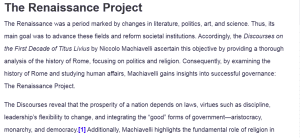The Renaissance Project
The Renaissance was a period marked by changes in literature, politics, art, and science. Thus, its main goal was to advance these fields and reform societal institutions. Accordingly, the Discourses on the First Decade of Titus Livius by Niccolo Machiavelli ascertain this objective by providing a thorough analysis of the history of Rome, focusing on politics and religion. Consequently, by examining the history of Rome and studying human affairs, Machiavelli gains insights into successful governance: The Renaissance Project.
The Discourses reveal that the prosperity of a nation depends on laws, virtues such as discipline, leadership’s flexibility to change, and integrating the “good” forms of government—aristocracy, monarchy, and democracy.[1] Additionally, Machiavelli highlights the fundamental role of religion in reforming institutions and uniting people. However, he emphasizes the need to handle religion cautiously, as it can be manipulated to fulfill selfish interests that harm society. In this regard, he cites an instance where a tribune wanted to pass a certain law, but the nobles retaliated by using religion to baffle the people, making them withdraw their support.[2]
Similarly, Francesco Petrarch’s letters represent the revival of literature and culture in the 1370s. By bringing to light the talent and eloquence of ancient authors, Petrarch’s letters helped establish the love for antiquity and inspired the shift to classical literature. The scholar also criticizes his contemporaries for their intellectual decline and moral decadence in comparison to the virtuous living of their ancestors.
In particular, he addresses Marcus Tullius Cicero, a long-dead Roman authoritative figure, where he critiques his approach to politics but praises his philosophical work, noting that he “spoke like an orator, wrote like a philosopher.”[3] Petrarch’s work, therefore, embodies humanism, the Renaissance goal that sought to revive classical culture and learning in the pursuit of intellectualism.
Niccolò Machiavelli and Francesco Petrarch preserved knowledge of the past by recovering, analyzing, and applying historical works to their texts. Machiavelli used Livius’ ancient works on Roman history and provided an analysis to ensure that the antique lessons learned were not lost but integrated into his contemporary statecraft. Likewise, Francesco recovered and used classical texts of long-forgotten ancient scholars like Cicero to reignite interest in literature and philosophy in his time. Accordingly, a modern-day practice that equates to the works of Machiavelli and Petrarch in preserving past knowledge is the digitization of historical scripts to preserve history and enable contemporary analysis and innovation.
Bibliography
Halsall, Paul. “Medieval Sourcebook: Francesco Petrarch: Letters, c 1372.” Fordham University, November 15, 2024. https://sourcebooks.fordham.edu/source/petrarch1.asp.
Project Gutenberg. “Discourses on the First Decade of Titus Livius, by Niccolo Machiavelli.” www.gutenberg.org, n.d. https://www.gutenberg.org/files/10827/10827-h/10827-h.htm.
[1] Project Gutenberg, “Discourses on the First Decade of Titus Livius, by Niccolo Machiavelli,” www.gutenberg.org, n.d., https://www.gutenberg.org/files/10827/10827-h/10827-h.htm.
[2] Project Gutenberg, “Discourses on the First Decade of Titus Livius, by Niccolo Machiavelli.”
[3] Paul Halsall, “Medieval Sourcebook: Francesco Petrarch: Letters, c 1372,” Fordham University, November 15, 2024, https://sourcebooks.fordham.edu/source/petrarch1.asp.
ORDER A PLAGIARISM-FREE PAPER HERE
We’ll write everything from scratch
Question 
In your final module, there are reading selections from two leading figures of the Italian Renaissance, Francesco Petrarch and Niccolo Machiavelli. Both of these writings are, in their way, representative of the Renaissance project. In your final essay of the course, I want you to address the following questions:
1. What was the main goal of the Renaissance, and how do these two readings exemplify that goal? You must cite both readings in your answer.
2. What type of work did these two authors do to preserve knowledge of the past? What would be a possible equivalent to that work today?

The Renaissance Project
Client’s Notes:
- USE THESE TWO LINKS TO ANSWER THE QUESTION NO OUTSIDE SOURCES PLEASE.
